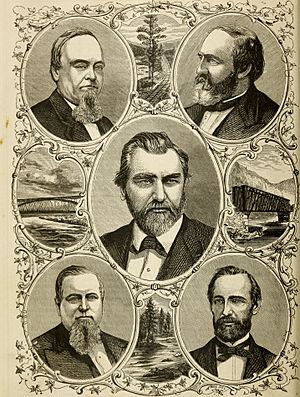Big Four (Central Pacific Railroad) facts for kids
"The Big Four" was a popular nickname for four very powerful businessmen. Their names were Leland Stanford, Collis Potter Huntington, Mark Hopkins Jr., and Charles Crocker. These men were railroad leaders and very rich. They helped fund and build the Central Pacific Railroad. This railroad was the western part of the First transcontinental railroad in the United States. It crossed the Sierra Nevada mountains and the Rocky Mountains. This huge project connected the country from the Missouri River to the Pacific Ocean. It was built in the mid-1860s.
The Big Four became incredibly wealthy from this work. They used government tax money and large land grants. They also had a lot of influence in politics. For example, Leland Stanford was the governor of California. Because of how they gained their wealth, some people called them "robber barons." This meant they got rich in ways that some thought were unfair. However, they personally preferred to be called "The Associates."
Contents
Who Were The Big Four?
The four members of "The Big Four" each played a key role:
- Leland Stanford (1824–1893)
- He was the President of the Central Pacific Railroad.
- Stanford later founded Stanford University, a famous school.
- Collis Potter Huntington (1821–1900)
- He was the Vice President of the Central Pacific Railroad.
- The city of Huntington, West Virginia is named after him.
- His nephew, Henry E. Huntington, founded the well-known Huntington Library.
- Mark Hopkins Jr. (1813–1878)
- He served as the Treasurer for the Central Pacific Railroad.
- Charles Crocker (1822–1888)
- He was in charge of construction for the railroad.
- Crocker later founded the larger Southern Pacific Transportation Company. This company built another transcontinental railroad link in 1883.
Their Impact and Legacy
The Big Four did more than just build railroads. They also helped their communities.
Supporting Education
In 1857, the four men together started the Sacramento Library Association. This was for the state capital city of Sacramento, California. This association later helped create the modern Sacramento Public Library.
Nob Hill
The Big Four built large, fancy homes in the same neighborhood in San Francisco. Because of their wealth and influence, this area became known as Nob Hill. This name is still used today.
Public Opinion
During their time, some people called these men "nobs." This was a short way of saying "nabobs," which meant very rich and powerful people. Not everyone admired them. For example, a writer named Ambrose Bierce made fun of the "Big Four" in his writings. He suggested they chose railroad work because it offered even more money than robbing stagecoaches. This shows that some people thought they were greedy.


